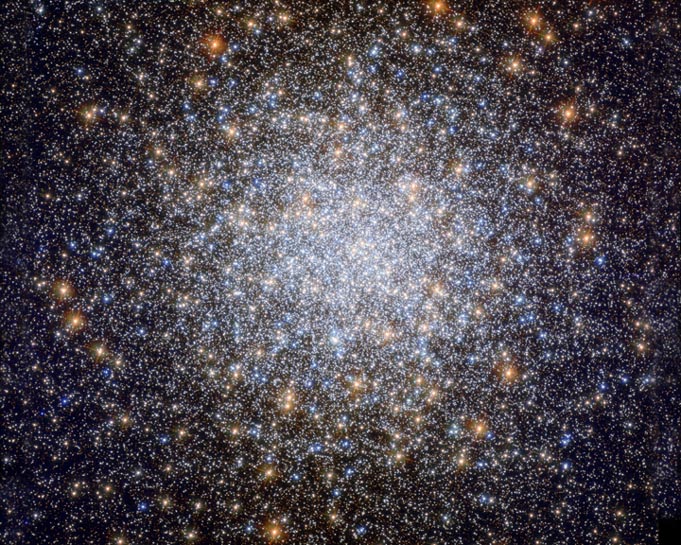
Globular Cluster
RA 13h 42m 11.80s Dec 28° 22' 31.69"
Canes Venatici
34,000 light years
6.2
18 arcminutes in diameter
2.78 x 2.43 arcminutes
North is 10.5° right of vertical
ESA/Hubble & NASA, G. Piotto et al.
April 8, 2019
ABOUT THIS IMAGE:
Globular clusters are inherently beautiful objects, but the subject of this NASA/ESA Hubble Space Telescope image, Messier 3, is commonly acknowledged to be one of the most beautiful of them all.
Containing an incredible half a million stars, this eight-billion-year-old cosmic bauble is one of the largest and brightest globular clusters ever discovered. However, what makes Messier 3 extra special is its unusually large population of variable stars — stars that fluctuate in brightness over time. New variable stars continue to be discovered in this sparkling stellar nest to this day, but so far we know of 274, the highest number found in any globular cluster by far. At least 170 of these are of a special variety called RR Lyrae variables, which pulse with a period directly related to their intrinsic brightness. If astronomers know how bright a star truly is based on its mass and classification, and they know how bright it appears to be from our viewpoint here on Earth, they can thus work out its distance from us. For this reason, RR Lyrae stars are known as standard candles — objects of known luminosity whose distance and position can be used to help us understand more about vast celestial distances and the scale of the cosmos.
Messier 3 also contains a relatively high number of so-called blue stragglers, which are shown quite clearly in this Hubble image. These are blue main sequence stars that appear to be young because they are bluer and more luminous than other stars in the cluster. As all stars in globular clusters are believed to have formed together and thus be roughly the same age. Only a difference in mass can give these stars a different color: a red, old star can appear bluer when it acquires more mass, for instance stripping it from a nearby star. The extra mass changes it into a bluer star, which makes us think it is younger than it really is.
From Wikipedia:
Messier 3 (M3 or NGC 5272) is a globular cluster of stars in the northern constellation of Canes Venatici. It was discovered on May 3, 1764, and was the first Messier object to be discovered by Charles Messier himself. Messier originally mistook the object for a nebula without stars. This mistake was corrected after the stars were resolved by William Herschel around 1784. Since then, it has become one of the best-studied globular clusters. Identification of the cluster's unusually large variable star population was begun in 1913 by American astronomer Solon Irving Bailey and new variable members continue to be identified up through 2004.
Many amateur astronomers consider it one of the finest northern globular clusters, following only Messier 13. M3 has an apparent magnitude of 6.2, making it a difficult naked eye target even with dark conditions. With a moderate-sized telescope, the cluster is fully defined. It can be a challenge to locate through the technique of star hopping, but can be found by looking almost exactly halfway along an imaginary line connecting the bright star Arcturus to Cor Caroli. Using a telescope with a 25 cm (9.8 in) aperture, the cluster has a bright core with a diameter of about 6 arcminutes and spans a total of 12 arcminutes.
This cluster is one of the largest and brightest, and is made up of around 500,000 stars. It is estimated to be 8 billion years old. It is located at a distance of about 33,900 light-years away from Earth.
Messier
3 is located 31.6 kly (9.7 kpc) above the Galactic plane and roughly 38.8
kly (11.9 kpc) from the center of the Milky Way. It contains 274 known
variable stars; by far the highest number found in any globular cluster.
These include 133 RR Lyrae variables, of which about a third display the
Blazhko effect of long-period modulation. The overall abundance of elements
other than hydrogen and helium, what astronomers term the metallicity,
is in the range of –1.34 to –1.50 dex. This value gives the
logarithm of the abundance relative to the Sun; the actual proportion
is 3.2–4.6% of the solar abundance. Messier 3 is the prototype for
the Oosterhoff type I cluster, which is considered "metal-rich".
That is, for a globular cluster, Messier 3 has a relatively high abundance
of heavier elements.